Major Reports and Resources
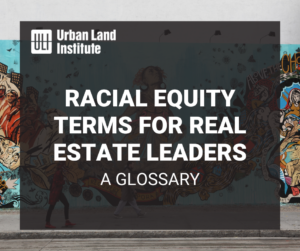 ULI Racial Equity Terms for Real Estate Leaders: A Glossary (2024)
ULI Racial Equity Terms for Real Estate Leaders: A Glossary (2024)
This glossary aims to elevate widely accepted definitions and help specific terms “come alive” for real estate professionals by demonstrating applications in real estate and development practice. Designed in an interactive online format, this glossary serves as a resource for real estate practitioners to better understand and advance action on core ideas and concepts, including antiracism, equitable development, and inclusion, among others.
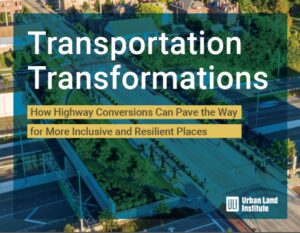 Transportation Transformations: How Highway Conversions Can Pave the Way for More Inclusive and Resilient Places (2023)
Transportation Transformations: How Highway Conversions Can Pave the Way for More Inclusive and Resilient Places (2023)
This report explores how transforming outdated automobile-oriented infrastructure can promote resilience, health, and equity—by identifying community priorities through robust engagement practices, creating new parks and green infrastructure, and employing nature-based solutions while supporting economic activity.
The Materials Movement: Creating Value with Better Building Materials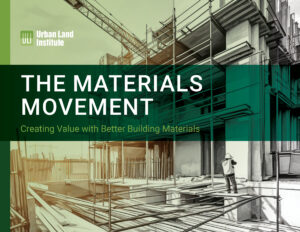 (2023)
(2023)
Furthering ULI’s work on embodied carbon in real estate, this report outlines the science behind how construction materials impact humans and the environment, makes the business case for better material choices, highlights strategies for incorporating health and sustainability in material selection, and showcases projects successfully addressing this issue.
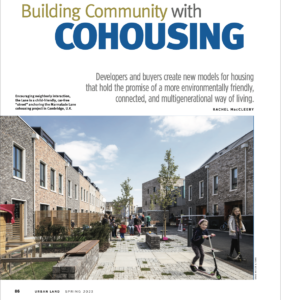
Building Community with Cohousing (2023)
Escalating housing prices, concerns about climate change, and a growing sense of loneliness and isolation are pushing people to reconsider how and where they live. Cohousing is a housing model that holds the promise of a more environmentally friendly, connected, and multigenerational way of living.
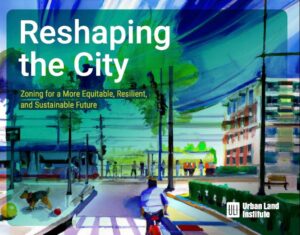
Reshaping the City: Zoning for a More Equitable, Sustainable, and Resilient Future (2023)
This report shares promising insights and examples of zoning updates from across the United States that have been crafted to promote healthy mobility, support increased housing affordability, build more resilient places, and accelerate climate action—among a host of other goals.
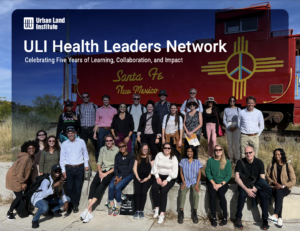 ULI Health Leaders Network: Celebrating Five Years of Learning, Collaboration, and Impact (2022)
ULI Health Leaders Network: Celebrating Five Years of Learning, Collaboration, and Impact (2022)
In 2017, ULI launched the Health Leaders Network with support from the Robert Wood Johnson Foundation, longtime ULI member and Foundation governor Randall Lewis, and the Colorado Health Foundation. Since then, the program has fostered five cohorts of over 190 individuals dedicated to harnessing their power and leadership to advance health and social equity in real estate and land use. In celebration of its five-year anniversary, this reflection piece showcases the program’s goals, milestones, and members’ experiences throughout the first five cohorts.
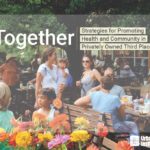 Together: Strategies for Promoting Health and Community in Privately Owned Third Places (2022)
Together: Strategies for Promoting Health and Community in Privately Owned Third Places (2022)
Third places—the places beyond homes and workplaces where people have opportunities to connect with others—are important components of a community. Privately owned spaces—stores, restaurants, and the like—are common places where people come together, places in which small, daily interactions occur, whether they are spontaneous or planned.
These spaces have the power to provide opportunities to local residents, foster community connections, be a common ground for civic discussion, and become economic drivers—all of which directly and indirectly affect the physical, mental, and social health and well-being of community members and visitors.
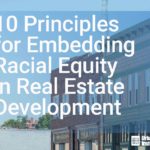 10 Principles for Embedding Racial Equity in Real Estate Development (2022)
10 Principles for Embedding Racial Equity in Real Estate Development (2022)
This report shares 10 guiding ideas that can help developers, investors, and other practitioners make racial equity a central part of their real estate practice. Each principle distills insights from industry leaders and includes specific best practices that can be applied to different sectors, markets, and geographies. These principles will help equip real estate professionals to deliver the financial and social benefits of equity to all stakeholders: developers and partners, the local community, and cities.
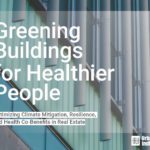 Greening Buildings for Healthier People (2022)
Greening Buildings for Healthier People (2022)
This report identifies building-scale opportunities to simultaneously and cost-effectively accelerate action on climate change and health, maximize their co-benefits, and manage any tensions between them. As a short primer, the report: 1) Explicitly makes the links between climate change and health strategies for a real estate audience; 2) Compiles opportunities for health-promoting investments in climate mitigation and resilience in one accessible document; and 3) Demonstrates the case for taking an integrated approach to health and climate strategies, including the many benefits for tenants, communities, and real estate.
 A Transformative Year: Impacts of 2020 on Real Estate (2021)
A Transformative Year: Impacts of 2020 on Real Estate (2021)
This report presents results from a Spring 2021 ULI survey that took the pulse of building owners and managers about the impacts of the past year, and especially the COVID-19 pandemic, on operations, finances, and DEI strategies. As the pandemic recedes in the United States, the survey results provide early insights on which changes are here to stay, and which are likely to be temporary. To showcase these insights and results in a series of visuals and facilitate the sharing of the key takeaways, this report is formatted as a slide deck.
 Change For Good: Lessons From ULI’s District Council Task Forces for Health and Social Equity (2021)
Change For Good: Lessons From ULI’s District Council Task Forces for Health and Social Equity (2021)
Member-led task forces organized by ULI district councils in Chicago, Phoenix, Sacramento, and Tampa worked during 2019 and 2020 to address local policy and regulatory barriers to the creation of healthier and more equitable places. Change for Good features executive summaries of each task force, including observations, findings, and recommendations. The report also documents common themes and takeaways gleaned from these experiences.
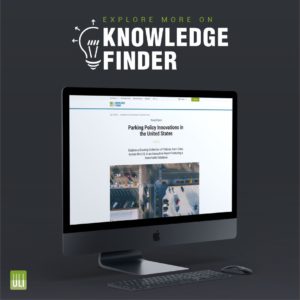 Parking Policy Innovations in the United States (2021)
Parking Policy Innovations in the United States (2021)
This interactive report allows users to access information on parking policies from cities across the United States. A searchable, filterable database includes a range of recent policy examples that represent significant shifts from the status quo depending on the local context.
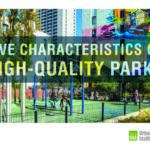 Five Characteristics of High-Quality Parks (2021)
Five Characteristics of High-Quality Parks (2021)
What makes one park high quality and another a disappointment? Across the country, cities as well as parks and recreation departments are seeking to articulate what “high quality” means. Based on interviews with parks professionals and other experts from around the country, this report presents a framework for park quality that can help all park developers and managers systematically assess quality, park by park and systemwide, to make investments and address longstanding disparities in access to high-quality parks.
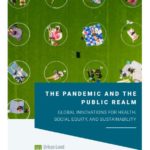 The Pandemic and the Public Realm (2021)
The Pandemic and the Public Realm (2021)
Featuring more than 30 innovative public space programs and projects since COVID-19 public health measures began in Spring 2020, The Pandemic and the Public Realm: Global Innovations for Health, Social Equity, and Sustainability showcases how temporary, flexible, equitable, and iterative projects can be more responsive to quickly changing needs while building support for future projects in the recovery.
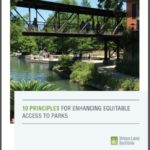 10 Principles for Enhancing Equitable Access to Parks (2021)
10 Principles for Enhancing Equitable Access to Parks (2021)
10 Principles for Enhancing Equitable Access to Parks distills and synthesizes key themes, lessons learned, and best practices from the recommendations of 14 Advisory Services panels and national study visits on parks and open spaces. By sharing lessons from cities’ steps toward more equitable park access, this report will serve as a resource for parks departments, developers, local officials, and anyone else seeking to improve equity in their park systems, and help leaders across sectors work toward healthier communities.
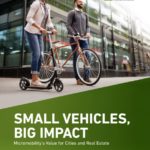 Small Vehicles, Big Impact: Micromobility’s Value for Cities and Real Estate (2021)
Small Vehicles, Big Impact: Micromobility’s Value for Cities and Real Estate (2021)
Although only one component of a transportation network, micromobility has the potential for an outsized impact on mobility, equity, and sustainability. Small Vehicles, Big Impact: Micromobility’s Value for Cities and Real Estate demonstrates the value of micromobility to the real estate industry, shows the growing case for real estate professionals to support micromobility (such as through providing onsite charging infrastructure), and helps city officials understand the real estate perspective on micromobility as they continue to regulate this rapidly evolving market. When the real estate industry and public sector are aligned, they can together promote micromobility usage, work toward a healthier transportation ecosystem, and ultimately shape more livable cities.
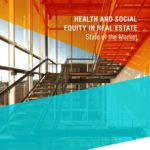 Health and Social Equity in Real Estate: State of the Market (2020)
Health and Social Equity in Real Estate: State of the Market (2020)
The Building Healthy Places Initiative, with support from HR&A and The Integral Group, released Health and Social Equity in Real Estate: State of the Market in Fall 2020. The report presents a snapshot of real estate professionals’ awareness and adoption of practices supporting health and social equity, and identifies opportunities for further inclusion of such practices by real estate organizations and ULI. More information on this assessment and its companion report, Health and Social Equity in Real Estate: Examples from the Field, is available here.
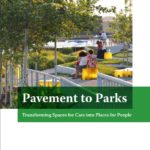 Pavement to Parks: Transforming Spaces for Cars into Places for People (2020)
Pavement to Parks: Transforming Spaces for Cars into Places for People (2020)
This report presents stories from across the United States and the globe of cities and organizations that have worked to transform or enhance spaces formerly dedicated to cars into parks and open spaces that support recreation, community engagement, sustainability and resilience, and neighborhood connectivity and revitalization.
The profiled projects and programs were chosen for their excellence and to illustrate various types of transformations spanning a wide range of geographies, scales, and costs. These rebirth stories require the engagement of many parties, including public-sector leaders, community members, developers, urban designers and landscape architects, and philanthropic and nonprofit organizations. Done well, pavement-to-park transformations can yield powerful dividends for real estate and communities.
Look around. Could that pavement you see be a park instead?
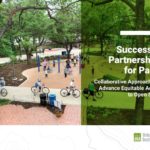 Successful Partnerships for Parks: Collaborative Approaches to Advance Equitable Access to Open Space (2020)
Successful Partnerships for Parks: Collaborative Approaches to Advance Equitable Access to Open Space (2020)
Real estate leaders are emerging as key players in supporting park creation, maintenance, and programming, and cross-sector partnerships among the real estate development industry, the public sector, nonprofit organizations, and the philanthropic community are proving essential for park success. Such partnerships can also enhance real estate value and support community health and well-being.
Countless partnership arrangements support parks. Each iteration, while unique, can offer insights to others embarking on journeys to create and sustain parks that promote health, resilience, social equity, and other goals. This report explores case studies and examples of successful partnerships for equitable parks, and distill lessons learned from these projects, to inform potential partnership arrangements.
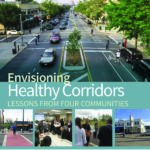
Envisioning Healthy Corridors: Lessons from Four Communities (2019)
A supplement to the 2016 publication Building Healthy Corridors: Transforming Urban and Suburban Arterials into Thriving Places, this report describes the experiences of and lessons learned from the four demonstration corridors that participated in the second phase of ULI’s Healthy Corridors project and provides a set of common recommendations from both phases of the project that can be implemented to improve health along commercial corridors.
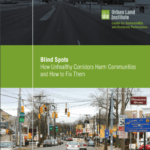
Blind Spots: How Unhealthy Corridors Harm Communities and How to Fix Them (2019)
This report by the Urban Land Institute and Smart Growth America examines unhealthy corridors, including their prevalence and location, the conditions they share, and the impact they have on people’s lives. It also explores the land use and transportation decisions that give rise to and perpetuate their existence, as well as opportunities to use policy and practice levers to shape them into something better. The appendix to the report can be accessed here.
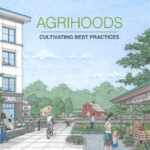 Agrihoods: Cultivating Best Practices (2018)
Agrihoods: Cultivating Best Practices (2018)
Inspired by a growing body of evidence that developments centered on working farms can have a positive effect on human health, environmental sustainability, and real estate performance, Agrihoods: Cultivating Best Practices identifies strategies to aid developers and their partners in planning, creating, and operating single-family, multifamily, or mixed-use communities built with a working farm as a focus.
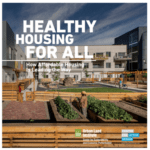 Healthy Housing for All (2018)
Healthy Housing for All (2018)
Healthy Housing for All explores the affordable housing industry’s achievements in creating healthier housing environments explores how health-promoting features in affordable, workforce, and mixed-income developments can support improved resident health outcomes and translates them into lessons for the broader housing marketplace.
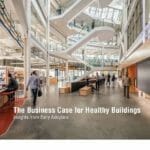
The Business Case for Healthy Buildings: Insights from Early Adopters (2018)
Inspired by a growing body of evidence that healthy buildings can have a positive effect on both human health and real estate performance, this report highlights the key certification standards in use in the marketplace, explores recent research on the impact of health-promoting design, and offers profiles of five projects that have been early adopters of healthy building and workplace design and management practices.
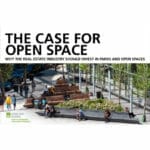
The Case for Open Space (2018)
How can investments in open space made by the private sector improve community health, support equitable development, and enhance real estate value? This publication outlines four compelling cases for developers to invest in open space, each supported by research and project briefs, as well as insights from developers, public officials, and others working at the intersection of open space and real estate development.
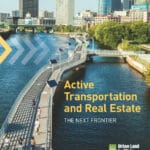
Active Transportation and Real Estate: The Next Frontier (2016)
This publication explores economic development, quality of life and infrastructure investment trends in active transportation and highlights projects at the leading edge of efforts to leverage investments in walking and bicycling.
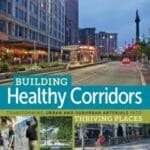
Building Healthy Corridors: Transforming Urban and Suburban Arterials into Thriving Places (2016)
This report explores strategies for transforming commercial corridors—found in nearly every community across the United States—into places that support the health of the people who live, work, and travel along them. It is the result of a two-year project that involved partnerships with four communities in the United States that are working to improve a specific corridor in ways that positively affect health.
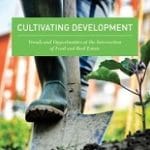
Cultivating Development: Trends and Opportunities at the Intersection of Food and Real Estate (2016)
This publication explores how developers are integrating food-based amenities—such as farms, gardens, food halls, restaurants, and grocery stores—within projects, thereby generating real estate value and benefits for people and the planet.
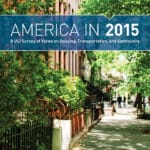
America in 2015 (2015)
The ULI Terwilliger Center for Housing partnered with the ULI Building Healthy Places Initiative on the ULI community survey America in 2015, assessing Americans’ views on their housing, transportation, and community options.
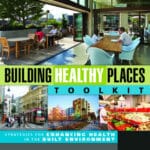
Building Healthy Places Toolkit: Strategies for Enhancing Health in the Built Environment (2015)
ULI’s Building Healthy Places Toolkit: Strategies for Enhancing Health in the Built Environment outlines evidence-supported opportunities for enhancing health outcomes in real estate developments. Developers, owners, property managers, designers, investors, and others involved in real estate decision making can use the report’s recommendations and strategies to create places that contribute to healthier people and communities, and to enhance and preserve value by meeting growing desires for health-promoting places. Learn more by visiting the Building Healthy Places Toolkit website.
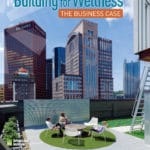 Building for Wellness: The Business Case (2014)
Building for Wellness: The Business Case (2014)
Does wellness make business sense as a development objective? How have developers pursued this objective? What has the market response been? And how have developers measured their success? To answer these questions, Building for Wellness: The Business Case highlights 13 projects of varying product type and scale that were developed with health and wellness in mind. In a series of profiles, developers share their motivation for incorporating a variety of health and wellness features, how these features factored into the overall development and operations process, and how the market has responded.
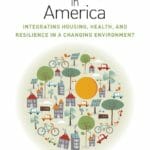
Housing in America: Integrating Housing, Health, and Resilience in a Changing Environment (2014)
This edition of ULI’s Housing in America report explores how households and communities across the country are responding to the impacts of extreme weather events. Through three case examples, this report also shares how communities are creating and sustaining healthier and more resilient environments in the face of an ever evolving climate.
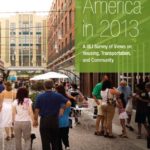 America in 2013 (2013)
America in 2013 (2013)
The Urban Land Institute’s Infrastructure Initiative and Terwilliger Center for Housing, in partnership with Belden Russonello Strategists LLC, a nationally recognized survey and communications firm, conducted a statistically representative survey of 1,202 adults living in the United States to understand their views on housing, transportation and community. The results of the survey are documented in America in 2013 and provide an important benchmark on American attitudes and expectations around community choices.
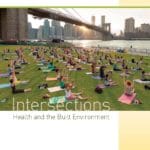
Intersections: Health and the Built Environment (2013)
This report explores global health trends and makes the link between those trends and what has been happening to our built environment. It looks at the relationship between how healthy we are and the way our buildings and communities function.
The report uses data and project examples drawn from around the world to make the case that we can build our way to better health by changing our approach to cities, communities, and places. Health challenges are daunting, but this publication shows how change can happen—one community, and one project, at a time.
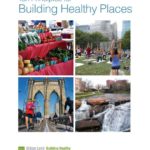 10 Principles for Building Healthy Places (2013)
10 Principles for Building Healthy Places (2013)